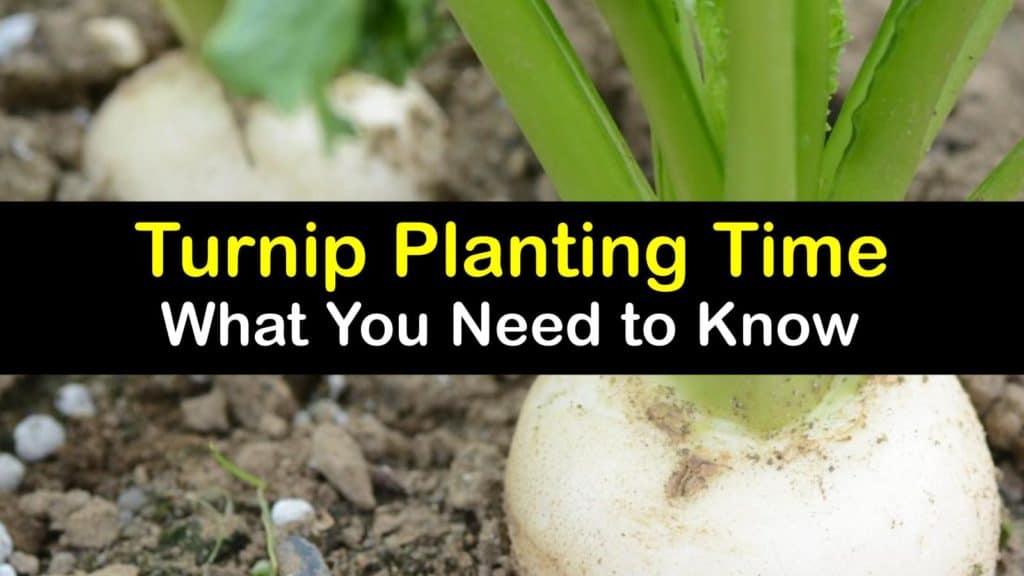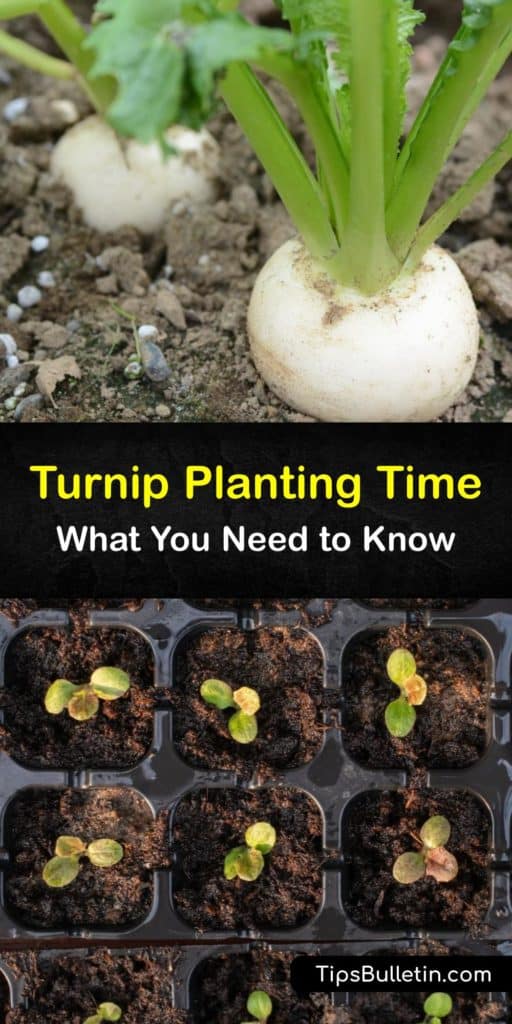Turnips belong to the mustard family and are similar to other root vegetables like rutabagas. Root crops may not be the star of the show, but they’re reliable and bring a welcome heartiness to meals. Educate yourself about when to plant turnips to enjoy this tasty root vegetable in home cooking.
Try baking, boiling, roasting, or mashing turnip roots, or using them in soup or pie. Although it’s standard to cook turnip, you can also eat young, tender roots raw. Turnip leaves have a similar flavor to mustard greens and are delicious cooked or in salad.
Turnips may not look like much, but both the leaves and roots are quite nutritious. The roots are high in fiber and vitamins, while turnip greens are a good source of folate, iron, calcium, and thiamine.

- Best Time to Plant Turnips
- Choosing a Turnip Variety
- When to Plant Turnips for a Spring or Fall Harvest
- When to Plant Turnip Seeds in Different Hardiness Zones
- Turnips Growing Season: Light and Temperature Requirements
- Getting Ready to Plant Turnips
- How to Plant Turnips
- How to Care for Turnip Plants
- Preventing Pests and Diseases on Turnip Plants
- How to Harvest Turnips
Best Time to Plant Turnips
Turnips—Brassica rapa—are a biennial but treated as an annual. The long, oval leaves have wavy edges and tiny hairs, and the plant may produce small yellow flowers. The bulbs are typically white or yellow, but their tops may turn purple or green upon exposure to sunlight.
When to plant turnip seeds depends on your zone and whether you plan to harvest the leaves, roots, or both. In any case, avoid hot weather as much as possible during the turnips growing season. Overly warm temperatures encourage woody root growth.
Choosing a Turnip Variety
When to plant turnip seeds depends on the variety. Different turnip cultivars form roots with different days to maturity, sizes, colors, and flavors. If you want a variety that excels at leaf production, try All Top, Topper, Seven Top, or Shogoin.
Oriental turnips like Tokyo Cross produce small, sweet white roots that are good for eating raw. Make sure to harvest red turnips early because the roots turn bitter as they age.
Yellow turnips have the best flavor after a couple of light frosts. Purple-topped turnips, meanwhile, produce greens over a long period and boast pollinator-friendly flowers in the spring.
When to Plant Turnips for a Spring or Fall Harvest
One of the factors influencing when to plant turnip seeds is when you wish to harvest the turnips. There are two main times for planting these cool-weather crops: in the early spring or late summer.

Spring planting allows you to harvest in late spring or early summer, while sowing seeds in late summer guarantees a fall crop. If sowing in the spring, do so two to three weeks before the last frost date.
Alternatively, start your turnips after summer veggies like onions, squash, beans, and corn. Continue sowing turnips seeds into October if winters are mild in your region. Note that fall turnips tend to be sweeter and more tender and suffer from fewer pests.
Make sure your turnips growing season includes at least two months of moderate weather before it gets very hot or freezes. Hot temperatures can cause tough, bitter roots and early bolting. A hard freeze, meanwhile, is likely to kill your turnip plants.
When to Plant Turnip Seeds in Different Hardiness Zones
Turnips are hardy to USDA zones 2 to 9. Check local weather averages or contact your local Cooperative Extension Service to confirm when to plant turnip seeds in your area.
Factors to consider include when the soil starts to warm in the spring, how hot it gets in the summer, and the average date for the first hard freeze in the fall.
In regions with a long, cool turnips growing season, succession planting ensures a continuous turnip crop. For these vegetables to plant in February in zone 7, sow seeds every two to three weeks as long as temperatures remain cool.
Turnips Growing Season: Light and Temperature Requirements
Turnips thrive in full sun or partial shade. Shady conditions are most suitable if you wish to grow turnips in your garden for their greens only.
The soil temperature must be above 40℉ for the seeds to sprout in a reasonable amount of time. The ideal temperature range for growing turnips is between 40 and 75℉.
As a cool-season crop, the bulbs form best when temperatures hover around 60℉. To enjoy the tastiest turnips and prevent bolting, avoid summer heat when planting and harvesting turnips.
Getting Ready to Plant Turnips
To help prevent disease, avoid planting at a site that has held plants in the Brassica genus within the past four years. On the other hand, consider planting near turnip companion plants.
Growing carrots next to turnips is fine and will give you yields of two delicious veggies nearly at the same time. Turnips are also a good companion plant for cucumbers.
To encourage germination and prevent root rot, ensure that the soil is rich in organic matter and well-drained. Before sowing turnip seeds, work in well-rotted manure or compost to increase soil fertility. Consider adding complete organic fertilizer as well.
Unfortunately, turnips are not great companion plants for potatoes. Plant something else nearby instead.
How to Plant Turnips
Sow turnip seeds a quarter- to a half-inch deep and one inch apart within rows. Space turnip rows 12 to 24 inches apart or scatter turnip seeds over a garden bed.
Gently rake them into the top quarter- to half-inch of soil. Water lightly to speed up germination. Turnip seeds should sprout in 7 to 14 days.
When the seedlings are a few inches tall, thin them to four to six inches apart—the thinned plants are tender and sweet. Crowding can lead to small, misshapen roots. If you’re growing turnips solely for their leaves, thin the plants to only two to three inches apart.
How to Care for Turnip Plants
Water regularly to encourage fast, healthy growth and prevent the roots from turning tough and bitter. Give your turnip plants approximately one inch of water per week to keep the earth lightly moist. Avoid getting the soil waterlogged since this could cause disease.
Like the best way to grow radishes, turnips do not generally require fertilizer since they grow so quickly. They also absorb the nitrogen left behind by summer crops like beans and corn.
Ensure that the soil is rich in organic matter before planting. Work in compost or manure before sowing the turnip seeds, and consider side-dressing with aged compost at midseason.
Keep your garden weed-free to prevent crowding, which leads to smaller turnips. Mulch heavily to retain moisture and discourage weeds. If you’ll be harvesting later in the turnips growing season, spread a thick layer of straw or mulch to protect the roots from freezing.
Preventing Pests and Diseases on Turnip Plants
Turnips are susceptible to several types of pests and fungal, bacterial, and viral diseases. Thankfully, they grow vigorously enough that pests and diseases do not tend to be a major issue.
As general preventative measures, rotate crops regularly, plant in nutrient-rich soil, avoid getting the soil soggy and weed frequently. Floating row covers help keep aphids and flea beetles away.
If you’re facing an aphid infestation, pick off infested leaves. You can also hose down the plant, spray soapy water or neem oil, or sprinkle diatomaceous earth.
Clubroot remains in the soil for up to seven years. Therefore, remove all affected plant matter and avoid planting any Brassicas at that site for at least seven years.
How to Harvest Turnips
Turnips’ harvest date depends on the variety and planting date. Turnip greens are ready to start harvesting about one month after planting and taste better when they’re young and tender.
Cut turnip leaves about two inches above the plant’s base—they may grow back. Harvest only a few mature, outer leaves at a time. Wash the greens well before use since their hairs catch dirt.
Expect the roots to be ready about two months after planting—check the seed packet to confirm the exact timeline. Turnip roots are most tender when they’re small, with a diameter of two to three inches.
Harvest fall turnips after a light frost or two but before the first hard freeze. To avoid bolting, harvest when temperatures are below 75℉. Carefully pull out the entire plant or dig it free using a shovel or garden fork.
Refrigerate turnip greens for up to seven days. Keep small turnip roots in perforated plastic bags in the fridge for up to two weeks. There are less carbs in turnips vs potatoes so use them as a substitute for mashed potatoes or other potato dishes.
Larger roots keep for several months in a cool, dark place like a root cellar, basement, or garage. Cut off the tops before storing your turnips.
Turnips are a reliable, fast-growing root crop to add to your vegetable garden. Plant them in cool weather to enjoy the tastiest, tenderest turnips.
Plant turnips in early spring for an early summer harvest or late summer for a fall one. Follow turnip tips like spacing your plants appropriately and watering them regularly to set your turnips up for success.
Become familiar with when to plant turnips to enjoy homegrown root veggies at your preferred time of year.

If you found these tips about the planting date for turnips helpful, please share this vegetable gardening information with your friends on Facebook and Pinterest.